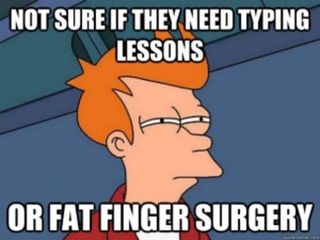
12 Ways to Prevent 'Fat Fingers'

This article was originally published on The Conversation. The publication contributed this article to Live Science's Expert Voices: Op-Ed & Insights.
Have you ever ordered too many items online – say, buying 20 courgettes when you meant two? Then you might feel a little sorry for the anonymous broker in Japan who lost US$617 billion to a trading typo error.
Perhaps what’s surprising is not so much that these mistakes are made, but that they happen so often traders have a name for it: a “fat finger” error, when someone enters a number they hadn’t intended, perhaps wrong by several decimal places, and generally to the bank’s loss.
This US$617 billion typo isn’t the first time such errors have been made, but it’s probably the largest. In 2009, another Japanese trader ordered £22 billion worth of shares in video game developer Capcom when he intended to buy £220,000. In 2002 a New York trader caused the Dow Jones index to plunge 100 points when he accidentally inflated his US$4m order to US$4 billion. In 2001 a trader at Lehman Brothers who intended to sell £3m of BP and AstraZeneca stocks added two zeros, selling £300m. The list of shame goes on, but there are probably far more smaller mistakes made every day.
You don’t need to be using online trading systems to lose big money. Mistyping numbers into a spreadsheet has proven equally problematic. An investigation into JP Morgan’s US$5.8 billion loss in 2012, the so-called “London Whale” trading debacle, blamed the amount of data entry needed to use a mathematical model developed in Excel.
Data-entry mistakes don’t just exist in banking, either. A US study by Kenneth Laudon for the Office of Technology Assessment in 1986 found that only 26% of the records sent by the FBI’s identification division were “complete, accurate and unambiguous”. In medicine the results can be fatal – a single zero or decimal out of place can be the difference between the correct dose or a fatal one. “Computer error” was the fourth-highest cause of mistakes, accounting for 13% of medication errors in 2003.
Aviation also has its moments, for example Air Inter Flight 148 crashed in 1992 killing 96 people; the crew wanted to set the angle of descent to 3.3 degrees but in error set it to descend at 3,300 feet per minute and the aircraft hit a mountain.
Sign up for the Live Science daily newsletter now
Get the world’s most fascinating discoveries delivered straight to your inbox.

12 ways to avoid a fat finger moment
Some ways to avoid your fat finger moment, then, hopefully when the stakes are not as high as death or bankruptcy.
- Stress is known to affect visual attention, which means taking a deep breath and taking your time when entering data.
- Repetitive data entry can lead to fatigue and what is known as familiarity blindness. If your hands get used to typing in the same number over and over, muscle memory might ensure they continue to do so, regardless of what you meant to type.
- Remind yourself you’re never an expert, because with greater skill comes greater unconscious automation of your actions, which means paying less attention to the display.
- Pay attention to the units. Ask yourself, is the computer using the same units as I am? Different countries teach different styles of number formatting in schools. For example 81,234.56 can be written as 81.234,56 (Denmark) or 81'234.56 (Switzerland) or 81 8234,56 (France) or 81,234/56 (Iran) or 81.234'56 (some parts of Spain) or 8,1234.56 (China). To further confuse, most software tends to default to US-style number (and date) formats. Remember to set everything up as you intend, rather than as you find it.
- In one study, double entry worked really well. This is why many websites prompt you to type your email addresses or passwords twice. If you can’t enter the numbers twice on the screen, enter a duplicate into a notepad. One study found visual checking resulted in 2,958% – that’s not a typing error – more data entry errors than double entry.
- Change modes. Try speaking the number out loud before pressing enter. Using cursor keys to select digits was found to be more accurate than typing in the numbers directly.
- Look after the decimal point. Most transposition errors (such as typing 53 instead of 35) occur after the decimal point.
- If you’re entering numbers into Excel try using the data validation features. It’s a pain to set up, but it could be better than losing your job or your money.
- If you can’t set limits in advance, one feature to try is the automatic cell background colour change, where numbers of different orders of magnitude switch to different colours.
- If you’re feeling extravagant, EEG can detect errors efficiently, but if working with electrodes attached to your head doesn’t appeal there are alternatives.
- If using an in-house data entry system, pressure the programmers to add some kind of checking behaviour, such as the colour-changing feature mentioned above, or double entry. After all, an error that undoes the company will put their jobs at risk too.
- Never buy anything that doesn’t have a proper Undo feature. The sort of “Are you sure?” dialogue doesn’t work because people get habituated to clicking it without thinking.
In one study it was found that data entry errors could be big enough to change the finding for a scientific experiment. In this era of big data, we tend to respect the numbers that come out of computers far more than we should. Without independent checks we should be careful about using any numbers too uncritically.
Errors come in all sizes – and not all of them can be solved by doubling up on courgette soup.
Nick Dalton does not work for, consult to, own shares in or receive funding from any company or organisation that would benefit from this article, and has no relevant affiliations.
This article was originally published on The Conversation. Read the original article. Follow all of the Expert Voices issues and debates — and become part of the discussion — on Facebook, Twitter and Google +. The views expressed are those of the author and do not necessarily reflect the views of the publisher. This version of the article was originally published on Live Science.













